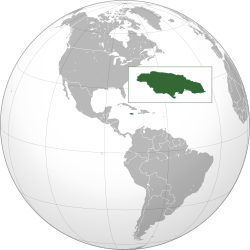Portal:Jamaica
The Jamaica Portal
Jamaica (/dʒəˈmeɪkə/ jə-MAY-kə; Jamaican Patois: Jumieka [dʒʌˈmie̯ka]) is an island country in the Caribbean Sea and the West Indies. At 10,990 square kilometres (4,240 sq mi), it is the third largest island—after Cuba and Hispaniola—of the Greater Antilles and the Caribbean. Jamaica lies about 145 km (90 mi) south of Cuba, 191 km (119 mi) west of Hispaniola (the island containing Haiti and the Dominican Republic), and 215 km (134 mi) south-east of the Cayman Islands (a British Overseas Territory). With 2.8 million people,0 Jamaica is the third most populous Anglophone country in the Americas (after the United States and Canada), and the fourth most populous country in the Caribbean. Kingston is the country's capital and largest city. Most Jamaicans are of Sub-Saharan African ancestry, with significant European, East Asian (primarily Chinese), Indian, Lebanese, and mixed-race minorities. Because of a high rate of emigration for work since the 1960s, there is a large Jamaican diaspora, particularly in Canada, the United Kingdom, and the United States. The country has a global influence that belies its small size; it was the birthplace of the Rastafari religion, reggae music (and such associated genres as dub, ska and dancehall), and it is internationally prominent in sports, including cricket, sprinting, and athletics. Jamaica has sometimes been considered the world's least populous cultural superpower. (Full article...) Selected article - Did you know (auto-generated)
Selected biography -Grace Beverly Jones OJ (born 19 May 1948) is a Jamaican singer, songwriter, model and actress. Born in Jamaica, she and her family moved to Syracuse, New York, when she was a teenager. Jones began her modelling career in New York state, then in Paris, working for fashion houses such as Yves St. Laurent and Kenzo, and appearing on the covers of Elle and Vogue. She notably worked with photographers such as Jean-Paul Goude, Helmut Newton, Guy Bourdin, and Hans Feurer, and became known for her distinctive androgynous appearance and bold features. Beginning in 1977, Jones embarked on a music career, securing a record deal with Island Records and initially becoming a high-profile figure of New York City's Studio 54-centered disco scene. In the early 1980s, she moved toward a new wave style that drew on reggae, funk, post-punk, and pop music, frequently collaborating with both the graphic designer Jean-Paul Goude and the musical duo Sly & Robbie. She scored Top 40 entries on the UK Singles Chart with "Private Life", "Pull Up to the Bumper", "I've Seen That Face Before", and "Slave to the Rhythm". In 1982, she released the music video collection A One Man Show, directed by Goude, which earned her a nomination for Best Video Album at the 26th Annual Grammy Awards. Her most popular albums include Warm Leatherette (1980), Nightclubbing (1981), and Slave to the Rhythm (1985). (Full article...)General images -The following are images from various Jamaica-related articles on Wikipedia.
This is a Good article, an article that meets a core set of high editorial standards.
Maymie de Mena (December 10, 1879 – October 23, 1953, also known as Maymie Aiken or Madame DeMena Aiken in her later career) was an American-born activist who became one of the highest-ranking officers in the Universal Negro Improvement Association (UNIA). She has been credited with keeping the organization alive after Marcus Garvey's conviction for mail fraud and deportation from the United States. De Mena was born into a Creole family in St. Martin Parish, Louisiana, and obtained her education in the United States before marrying a Nicaraguan and moving to Central America. After a decade in which she raised a daughter and taught school, she divorced, returned to the U.S., and joined the UNIA. Quickly rising in the ranks from a translator, because she was fluent in Spanish, de Mena became one of the leaders of the pan-African movement. She was responsible for increasing the membership of the organization in the Caribbean and Latin America. When Garvey was deported from the U.S. to Jamaica, de Mena became Garvey's official representative in New York and was the first woman to carry such a high distinction in the organization. (Full article...)Selected picture -Selected cuisines, dishes and foods -Pickapeppa Sauce, also known as Jamaican ketchup, is a brand-name Jamaican condiment, the main product of the Pickapeppa Company, founded in 1921. It is made in Shooters Hill, Jamaica, near Mandeville. The ingredients (in order on the product label) are cane vinegar, sugar, tomatoes, onions, raisins, sea salt, ginger, peppers, garlic, cloves, black pepper, thyme, mangoes, and orange peel, aged in oak barrels. The sauce is sweet, sour, and mildly spicy. The company makes several variants of the sauce, including mango and extra-hot Scotch bonnet pepper varieties. One traditional use of the sauce is to pour it over a block of cream cheese, to be spread on crackers. (Full article...)
More did you know
Selected listsTopicsCategoriesRelated portals
WikiProjectsGeographical:
History and Society:
Tasks
Associated WikimediaThe following Wikimedia Foundation sister projects provide more on this subject:
More portals | ||||||||||





















































